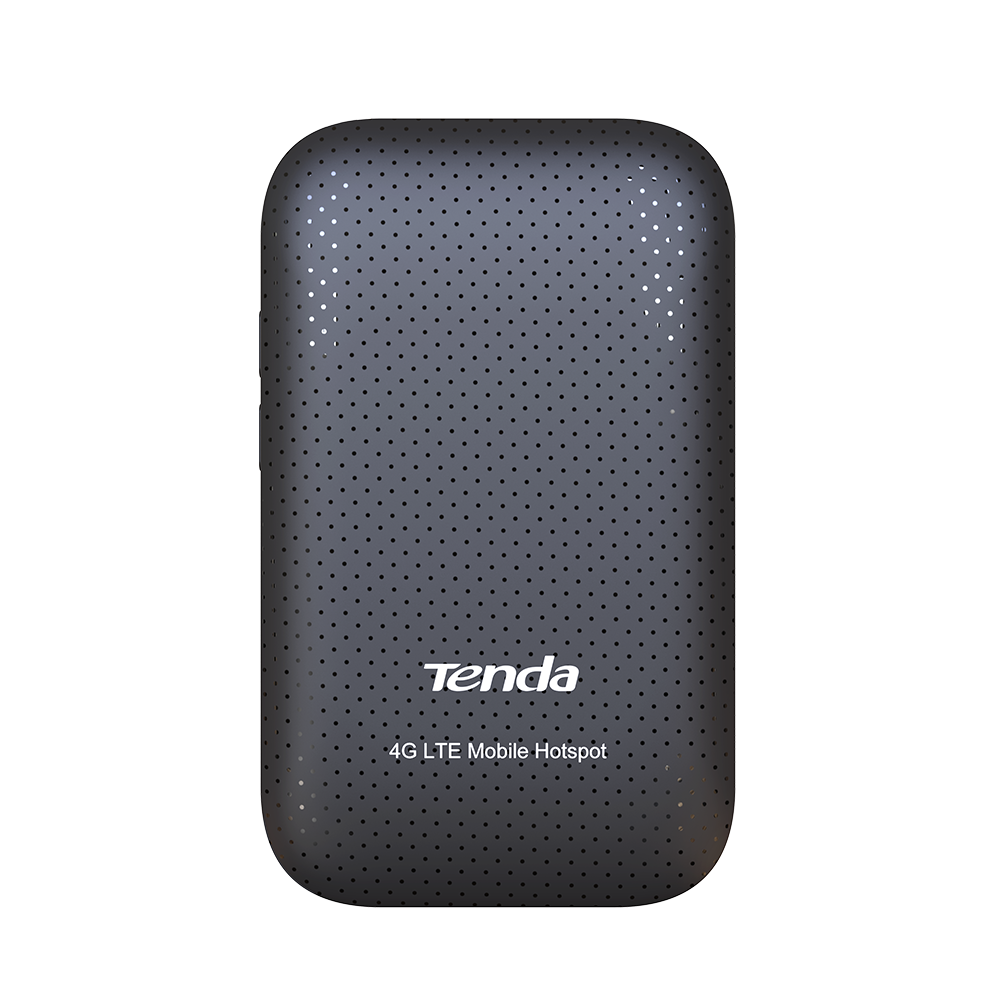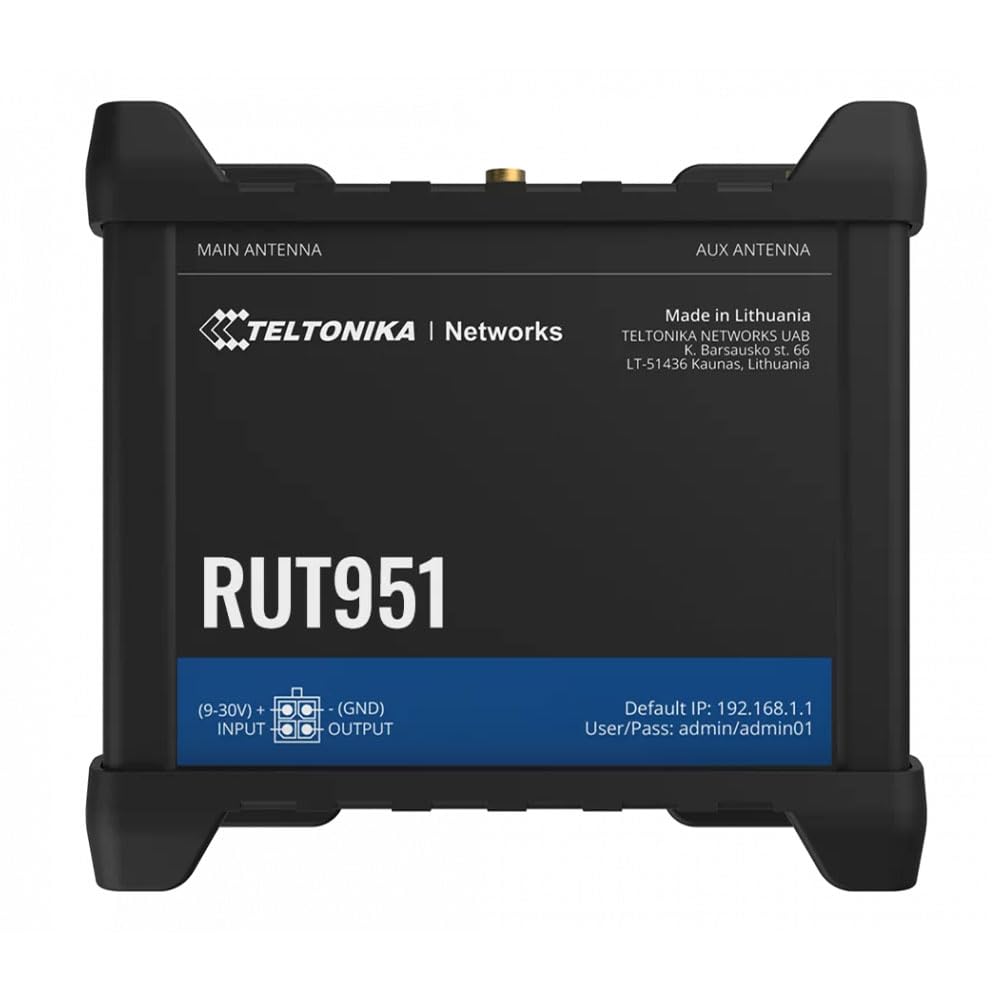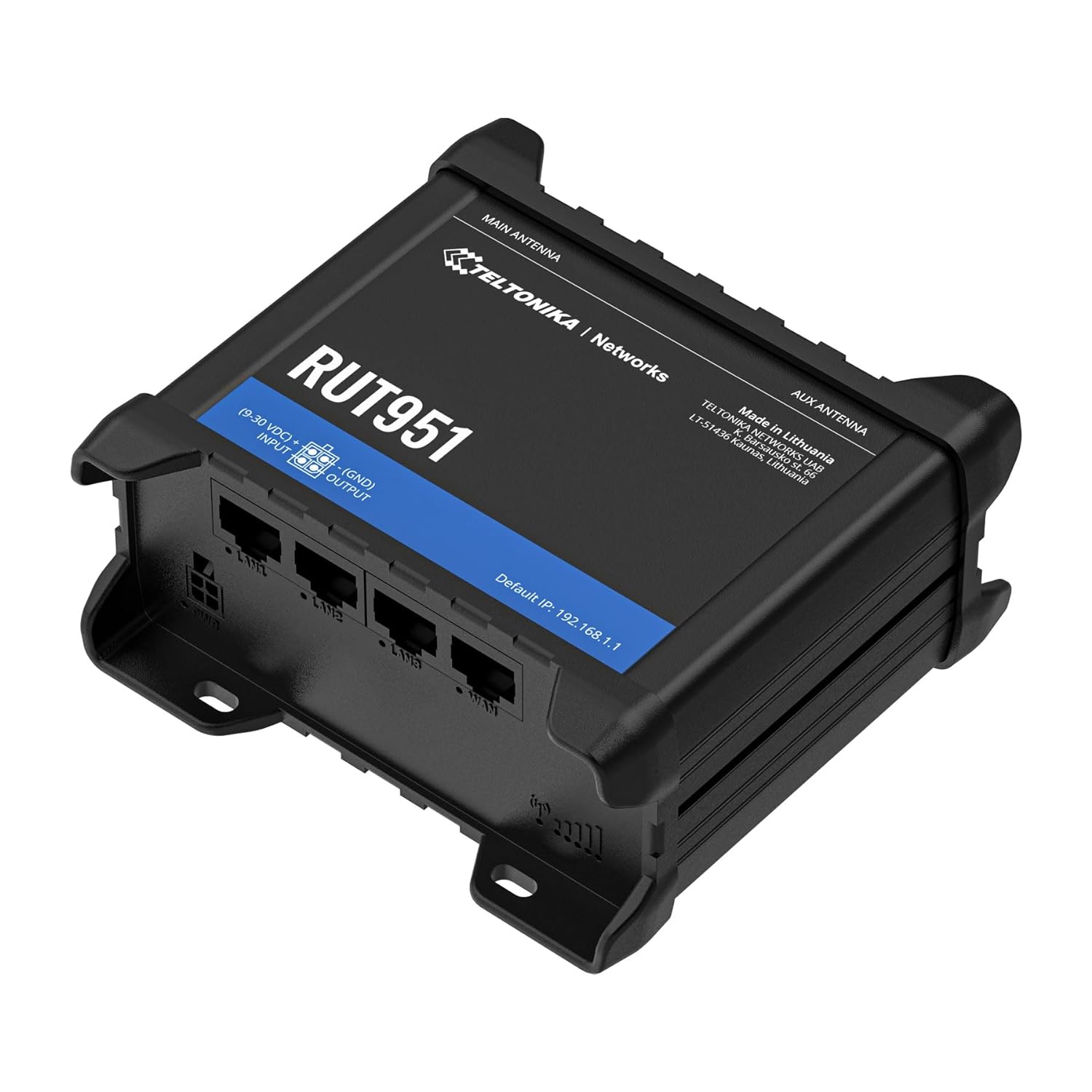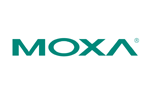Subtotal: ₹31,777.97 GST
Teltonika RUT951 Industrial 4G LTE Router
RUT951 features dual-SIM cellular connectivity combined with Wi-Fi and four Ethernet interfaces to meet the needs of the most varied IoT scenarios. Powered by RutOS, this router offers advanced customization options, automation features, and top-level security for your solution.
₹19,999.00 ₹29,999.00 Inc. GST
- RUT951 took the best features from one of the most popular Teltonika Networks cellular routers – RUT950.
- This device features dual SIM 4G cellular connectivity combined with Wi-Fi and 4 Ethernet interfaces to meet the needs of the most varied IoT solutions.
- Automatic WAN failover to an available backup connection ensures network continuity and eliminates downtime.
- Powered by RutOS that offers customization options for professional use, automation features, and top-level security for your solution.
- Compatible with the Teltonika Networks Remote Management System (RMS) enables secure remote management to save time and expenses.
- 3x LAN, 1x WAN 10/100 Ethernet Ports
- 2.4 GHz 802.11n WiFi 2X2 MIMO
- 9 to 36 Vdc Molex connector with 240 Vac power supply
- Can be powered by Passive PoE injector on LAN1 port
- Dynamic DNS, DHCP Relay, Web filters
- 2x Removable Cellular Antennas, 2x WiFi antennas
- SMS Config & Ping reboot
- Dual SIM (standard size) with carrier failover.
- Telstra.Corp and Private APNs fully functional
- 4G (LTE) – Cat 4 Up to 150 Mbps (but limited to 100Mbps by ethernet port)
- 3G – Up to 42 Mbps
- 2G – Up to 236.8 kbps
| Brands | Teltonika Networks |
|---|
-
Mobile module
4G (LTE) – Cat 4 up to 150 Mbps, 3G – Up to 42 Mbps, 2G – Up to 236.8 kbps
-
3GPP Release
Release 10/11 depending on the hardware version
-
SIM switch
2 SIM cards, auto-switch cases: weak signal, data limit, SMS limit, roaming, no network, network denied, data connection fail, SIM idle protection
-
Status
Signal strength (RSSI), SINR, RSRP, RSRQ, EC/IO, RSCP, Bytes sent/received, connected band, IMSI, ICCID
-
SMS
SMS status, SMS configuration, send/read SMS via HTTP POST/GET, EMAIL to SMS, SMS to EMAIL, SMS to HTTP, SMS to SMS, scheduled SMS, SMS autoreply, SMPP
-
USSD
Supports sending and reading Unstructured Supplementary Service Data messages
-
Black/White list
Operator black/white list
-
Multiple PDN
Possibility to use different PDNs for multiple network access and services
-
Band management
Band lock, Used band status display
-
APN
Auto APN
-
Bridge
Direct connection (bridge) between mobile ISP and device on LAN
-
Passthrough
Router assigns its mobile WAN IP address to another device on LAN
-
Wireless mode
IEEE 802.11b/g/n, Access Point (AP), Station (STA)
-
Wi-Fi security
WPA2-Enterprise – PEAP, WPA2-PSK, WEP, WPA-EAP, WPA-PSK; AES-CCMP, TKIP, Auto Cipher modes, client separation
-
SSID/ESSID
SSID stealth mode and access control based on MAC address
-
Wi-Fi users
Up to 100 simultaneous connections
-
Wireless Connectivity Features
Fast roaming (802.11r), Relayd
-
Wireless MAC filter
Whitelist, blacklist
-
Wireless QR code generator
Once scanned, a user will automatically enter your network without needing to input login information.
-
Hotspot
Captive portal (Hotspot), internal/external Radius server, SMS authorization, internal/external landing page, walled garden, user scripts, URL parameters, user groups, individual user or group limitations, user management, 9 default customizable themes and option to upload and download customised hotspot themes
-
Routing
Static routing, Dynamic routing (BGP, OSPF v2, RIP v1/v2, EIGRP, NHRP), Policy based routing
-
Network protocols
TCP, UDP, IPv4, IPv6, ICMP, NTP, DNS, HTTP, HTTPS, SFTP, FTP, SMTP, SSL/TLS, ARP, VRRP, PPP, PPPoE, UPNP, SSH, DHCP, Telnet, SMPP, SMNP, MQTT, Wake On Lan (WOL)
-
VoIP passthrough support
H.323 and SIP-alg protocol NAT helpers, allowing proper routing of VoIP packets
-
Connection monitoring
Ping Reboot, Wget Reboot, Periodic Reboot, LCP and ICMP for link inspection
-
Firewall
Port forward, traffic rules, custom rules
-
Firewall status page
View all your Firewall statistics, rules, and rule counters
-
Ports management
View device ports, enable and disable each of them, turn auto-configuration on or off, change their transmission speed, and so on
-
Network topology
Visual representation of your network, showing which devices are connected to which other devices
-
Hotspot
Captive portal (Hotspot), internal/external Radius server, SMS authorization, internal/external landing page, walled garden, user scripts, URL parameters, user groups, individual user or group limitations, user management, 9 default customizable themes and option to upload and download customised hotspot themes
-
DHCP
Static and dynamic IP allocation, DHCP Relay
-
QoS / Smart Queue Management (SQM)
Traffic priority queuing by source/destination, service, protocol or port, WMM, 802.11e
-
DDNS
Supported >25 service providers, others can be configured manually
-
Network backup
Wi-Fi WAN, Mobile, VRRP, Wired options, each of which can be used as an automatic Failover
-
Load balancing
Balance Internet traffic over multiple WAN connections
-
SSHFS
Possibility to mount remote file system via SSH protocol
-
WAN
1 x WAN port 10/100 Mbps, compliance IEEE 802.3, IEEE 802.3u standards, supports auto MDI/MDIX
-
LAN
3 x LAN ports, 10/100 Mbps, compliance IEEE 802.3, IEEE 802.3u standards, supports auto MDI/MDIX
-
Authentication
Pre-shared key, digital certificates, X.509 certificates, TACACS+, Radius, IP & Login attempts block
-
Firewall
Pre-configured firewall rules can be enabled via WebUI, unlimited firewall configuration via CLI; DMZ; NAT; NAT-T
-
Attack prevention
DDOS prevention (SYN flood protection, SSH attack prevention, HTTP/HTTPS attack prevention), port scan prevention (SYN-FIN, SYN-RST, X-mas, NULL flags, FIN scan attacks)
-
VLAN
Port and tag-based VLAN separation
-
Mobile quota control
Mobile data limit, customizable period, start time, warning limit, phone number
-
WEB filter
Blacklist for blocking out unwanted websites, Whitelist for specifying allowed sites only
-
Access control
Flexible access control of SSH, Web interface, CLI and Telnet
-
OpenVPN
Multiple clients and a server can run simultaneously, 27 encryption methods
-
OpenVPN Encryption
DES-CBC 64, RC2-CBC 128, DES-EDE-CBC 128, DES-EDE3-CBC 192, DESX-CBC 192,
BF-CBC 128, RC2-40-CBC 40, CAST5-CBC 128, RC2-64-CBC 64, AES-128-CBC 128, AES-128-CFB 128, AES-128-CFB1 128, AES-128-CFB8 128, AES-128-OFB 128, AES-128-GCM 128, AES-192-CFB 192, AES-192-CFB1 192, AES-192-CFB8 192, AES-192-OFB 192, AES-192-CBC 192, AES-192-GCM 192, AES-256-GCM 256, AES-256-CFB 256, AES-256-CFB1 256, AES-256-CFB8 256, AES-256-OFB 256, AES-256-CBC 256
-
IPsec
IKEv1, IKEv2, with 14 encryption methods for IPsec (3DES, DES, AES128, AES192, AES256, AES128GCM8, AES192GCM8, AES256GCM8, AES128GCM12, AES192GCM12, AES256GCM12, AES128GCM16, AES192GCM16, AES256GCM16)
-
GRE
GRE tunnel, GRE tunnel over IPsec support
-
PPTP, L2TP
Client/Server instances can run simultaneously, L2TPv3, L2TP over IPsec support
-
Stunnel
Proxy designed to add TLS encryption functionality to existing clients and servers without any changes in the program’s code
-
DMVPN
Method of building scalable IPsec VPNs
-
SSTP
SSTP client instance support
-
ZeroTier
ZeroTier VPN client support
-
WireGuard
WireGuard VPN client and server support
-
Tinc
Tinc offers encryption, authentication and compression in it’s tunnels. Client and server support.
-
Supported modes
Client, Server (planned)
-
Supported connection types
TCP
-
ID range
Respond to one ID in range [1;255] or any
-
Allow Remote Access
Allow access through WAN
-
Custom registers
MODBUS TCP custom register block requests, which read/write to a file inside the router, and can be used to extend MODBUS TCP Slave functionality
-
Supported functions
01, 02, 03, 04, 05, 06, 15, 16
-
Supported data formats
8-bit: INT, UINT; 16-bit: INT, UINT (MSB or LSB first); 32-bit: float, INT, UINT (ABCD (big-endian), DCBA (little-endian), CDAB, BADC)
-
Protocol
HTTP(S), MQTT, Azure MQTT, Kinesis
-
Data to server
Extract parameters from multiple sources and different protocols, and send them all to a single server
-
MQTT Gateway
Allows sending commands and receiving data from MODBUS Master through MQTT broker
-
Supported modes
TCP Master, DNP3 Outstation
-
DLMS Support
DLMS – standard protocol for utility meter data exchange
-
WEB UI
HTTP/HTTPS, status, configuration, FW update, CLI, troubleshoot, event log, system log, kernel log
-
FOTA
Firmware update from server, automatic notification
-
SSH
SSH (v1, v2)
-
SMS
SMS status, SMS configuration, send/read SMS via HTTP POST/GET
-
Call
Reboot, Status, Mobile data on/off, Output on/off, answer/hang-up with a timer, Wi-Fi on/off
-
TR-069
OpenACS, EasyCwmp, ACSLite, tGem, LibreACS, GenieACS, FreeACS, LibCWMP, Friendly tech, AVSystem
-
MQTT
MQTT Broker, MQTT publisher
-
SNMP
SNMP (v1, v2, v3), SNMP Trap
-
JSON-RPC
Management API over HTTP/HTTPS
-
MODBUS
MODBUS TCP status/control
-
RMS
Teltonika Remote Management System (RMS)
-
Cloud of Things
Allows monitoring of: Device data, Mobile data, Network info, Availability
-
ThingWorx
Allows monitoring of: WAN Type, WAN IP, Mobile Operator Name, Mobile Signal Strength, Mobile Network Type
-
Cumulocity
Allows monitoring of: Device Model, Revision and Serial Number, WAN Type and IP, Mobile Cell ID, ICCID, IMEI, Connection Type, Operator, Signal Strength
-
Azure IoT Hub
Can send device IP, Number of bytes send/received, Temperature, PIN count to Azure IoT Hub server, Mobile connection state, Network link state, IMEI, ICCID, Model, Manufacturer, Serial, Revision, IMSI, SIM State, PIN state, GSM signal, WCDMA RSCP, WCDMA EC/IO, LTE RSRP, LTE SINR, LTE RSRQ, CELL ID, Operator, Operator number, Connection type
-
CPU
Mediatek, 580 MHz, MIPS 24KEc
-
RAM
128 MB, DDR2
-
FLASH storage
16 MB, SPI Flash
-
WEB UI
Update FW from file, check FW on server, configuration profiles, configuration backup
-
FOTA
Update FW
-
RMS
Update FW/configuration for multiple devices at once
-
Keep settings
Update FW without losing current configuration
-
Operating system
RutOS (OpenWrt based Linux OS)
-
Supported languages
Busybox shell, Lua, C, C++
-
Development tools
SDK package with build environment provided
-
GPL customization
You can now create your own custom firmware and web page application, with some examples to make the creation process easier; and brand our firmware by changing colours, logos, and so on to fit your or your clients’ needs.
-
Input
1 x Digital Input, 0 – 6 V detected as logic low, 8 – 30 V detected as logic high
-
Output
1 x Digital Output, Open collector output, max output 30 V, 300 mA
-
Events
Email, RMS, SMS
-
I/O juggler
Allows to set certain I/O conditions to initiate event
-
Connector
4-pin industrial DC power socket
-
Input voltage range
9 – 30 VDC, reverse polarity protection; surge protection >31 VDC 10us max
-
PoE (passive)
Passive PoE over spare pairs. Possibility to power up through LAN1 port, not compatible with IEEE802.3af, 802.3at and 802.3bt standards, Mode B, 9 – 30 VDC
-
Power consumption
< 2 W idle, < 7 W Max
-
Ethernet
4 x RJ45 ports, 10/100 Mbps
-
I/O’s
1 x Digital Input, 1 x Digital Output on 4-pin power connector
-
Status LEDs
1 x Bi-color connection status, 5 x Mobile connection strength, 4 x ETH status, 1 x Power
-
SIM
2 x SIM slots (Mini SIM – 2FF), 1.8 V/3 V, external SIM holders, eSIM (Optional)
-
Antennas
2 x SMA for LTE, 2 x RP-SMA for Wi-Fi antenna connectors
-
Reset
Reboot/User default reset/Factory reset button
-
Casing material
Aluminium housing, plastic panels
-
Dimensions (W x H x D)
110 x 50 x 100 mm
-
Weight
287 g
-
Mounting options
DIN rail (can be mounted on two sides), flat surface placement
-
Operating temperature
-40 °C to 75 °C
-
Operating humidity
10% to 90% non-condensing
-
Ingress Protection Rating
IP30
-
Regulatory
CE, UKCA, ANRT, Kenya, CITC, ICASA, FCC, IC, PTCRB, RCM, Giteki, ECE R118, E-mark, CB, UL/CSA Safety, RoHS, REACH
-
Operator
AT&T, Verizon, T-Mobile
-
Standards
EN 55032:2015 + A11:2020
EN 55035:2017 + A11:2020
EN IEC 61000-3-2:2019 + A1:2021
EN 61000-3-3:2013 + A1:2019
EN 301 489-1 V2.2.3
EN 301 489-17 V3.2.4
EN 301 489-52 V1.2.1
-
ESD
EN 61000-4-2:2009
-
Radiated Immunity
EN 61000-4-3:2020
-
EFT
EN 61000-4-4:2012
-
Surge Immunity (AC Mains Power Port)
EN 61000-4-5:2014 + A1:2017
-
CS
EN 61000-4-6:2014
-
DIP
EN 61000-4-11:2020
-
Standards
EN 300 328 V2.2.2
EN 301 511 V12.5.1
EN 301 908-1 V15.2.1
EN 301 908-2 V13.1.1
EN 301 908-13 V13.2.1
-
Standards
CE: EN IEC 62368-1:2020 + A11:2020, EN IEC 62311:2020, EN 50665:2017
RCM: AS/NZS 62368.1:2022
CB: IEC 62368-1:2018
UL/CSA Safety: UL 62368-1 (3rd Ed., Rev. December 13, 2019), C22.2 No. 62368-1:19 (3rd Ed., Rev. December 13, 2019)
Related products
-
Computer Networking, Load Balancer, Router
TP-Link TL-ER5120 Version 4 Gigabit Load Balance Broadband Router
-21% Computer Networking, Load Balancer, Router
Computer Networking, Load Balancer, RouterTP-Link TL-ER5120 Version 4 Gigabit Load Balance Broadband Router
0 out of 5(0)The TL-ER5120 Gigabit Load Balance Broadband Router from TP-Link possesses exceptional data processing capabilities and a rich array of features including Load Balance, Access Control, DoS Defense, Bandwidth Control, and Session Limit.
SKU: TL-ER5120₹14,999.00₹18,999.00Inc. GST -
Access Point, Computer Networking
TP-Link EAP115-Wall 300Mbps Wireless N Wall-Plate Access Point
-25% Access Point, Computer Networking
Access Point, Computer NetworkingTP-Link EAP115-Wall 300Mbps Wireless N Wall-Plate Access Point
0 out of 5(0)- Easy-mount construction allows installation into any standard EU-type data wall-box
- Compact, low-profile design fits discreetly with any existing interior style
- Cloud Controller Software enables administrators to easily manage hundreds of EAPs
- Support Power over Ethernet (802.3af) for convenient and affordable installation
- Enterprise-class Wi-Fi security helps to decrease network security threats
- Captive portal provides one convenient method of authentication for Wi-Fi guests
- Supports management VLAN for an enhanced network management
SKU: EAP115-Wall₹2,999.00₹3,999.00Inc. GST -
Computer Networking, Networking Switches
TP-Link TL-SG1048 48-Port Gigabit Rackmount Switch
0 out of 5(0)The 48-Port Gigabit Switch TL-SG1048 is designed to meet the needs of the most demanding workgroup and departmental connectivity requirements. A reliable, easy-to-use switch without the complexity of management, the TL-SG1048 provides 48 10/100/1000Mbps ports. The TL-SG1048 combines ease of use with unsurpassed performance resulting in an exceptional value for any cost-conscious network administrator who wants the best possible solution at the best possible price.
SKU: TL-SG1048₹15,999.00₹29,999.00Inc. GST -
Computer Networking, Networking Switches
TP-Link TL-MC1400 14 Slot Rackmount Chassis
0 out of 5(0)The TL-MC1400 14-Slot Rack-mount Chassis is specially designed to accommodate 14 TP-LINK‘s Media Converters for central power supply, saving space and power cables.
SKU: TL-MC1400₹16,999.00₹24,999.00Inc. GST -
Access Point, Computer Networking
TP-Link EAP225-Outdoor AC1200 Wireless MU-MIMO Gigabit Outdoor Access Point
-49% Access Point, Computer Networking
Access Point, Computer NetworkingTP-Link EAP225-Outdoor AC1200 Wireless MU-MIMO Gigabit Outdoor Access Point
0 out of 5(0)Extend the reach of your Wi-Fi network outdoors with the EAP225-Outdoor Wireless AC1200 Gigabit Indoor/Outdoor Access Point from TP-Link. This wireless-AC access point operates on the 802.11a/b/g/n/ac Wi-Fi network standards and operates on both the 2.4 GHz and 5 GHz frequencies supporting data transfer rates of up to 1200 Mb/s. In addition to enhanced wireless coverage and network speeds, this access point is designed to stand up against the elements, thanks to the durable weatherproof housing. Installation is simple, as the EAP225-Outdoor access point comes with both pole- and wall-mounting kits and supports PoE connectivity to eliminate the need to run a standalone power supply to the AP. Once installed, free Omada Controller Software makes it easy to manage this AP as well as hundreds of other APs while the captive portal simplifies the process of authenticating guests.
SKU: EAP225-Outdoor₹6,599.00₹12,999.00Inc. GST


















